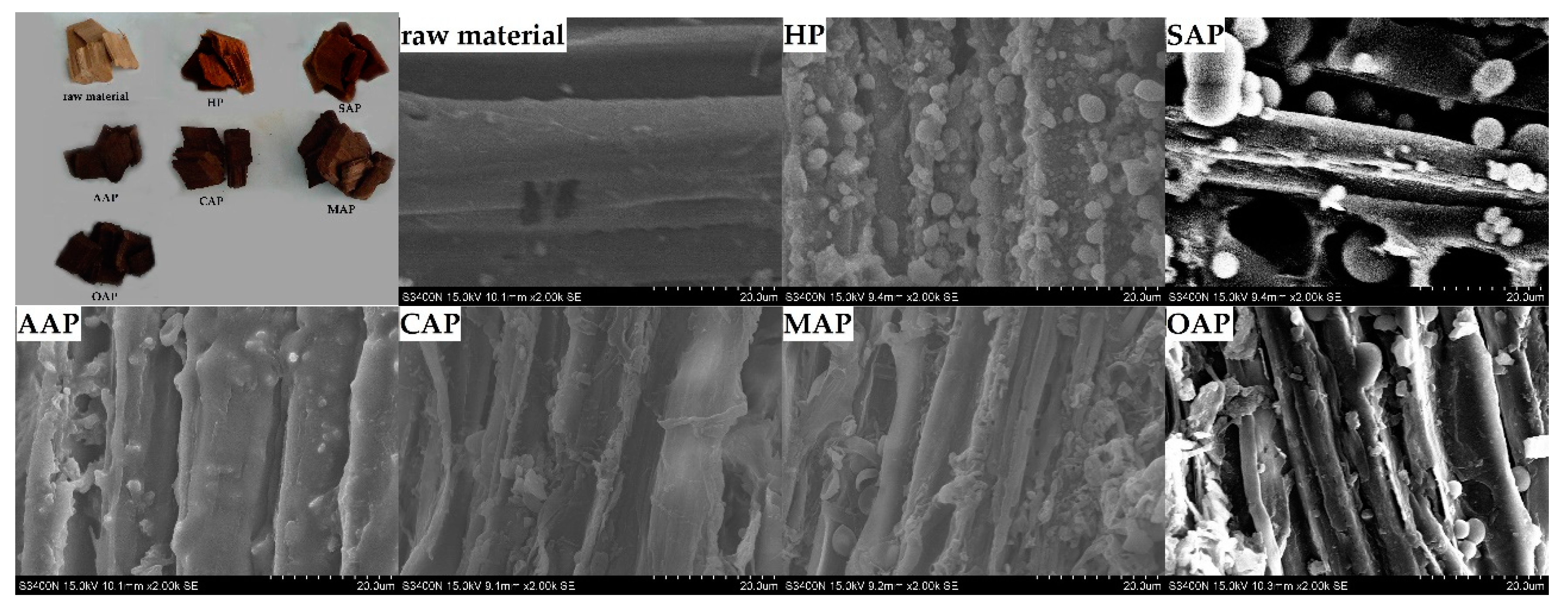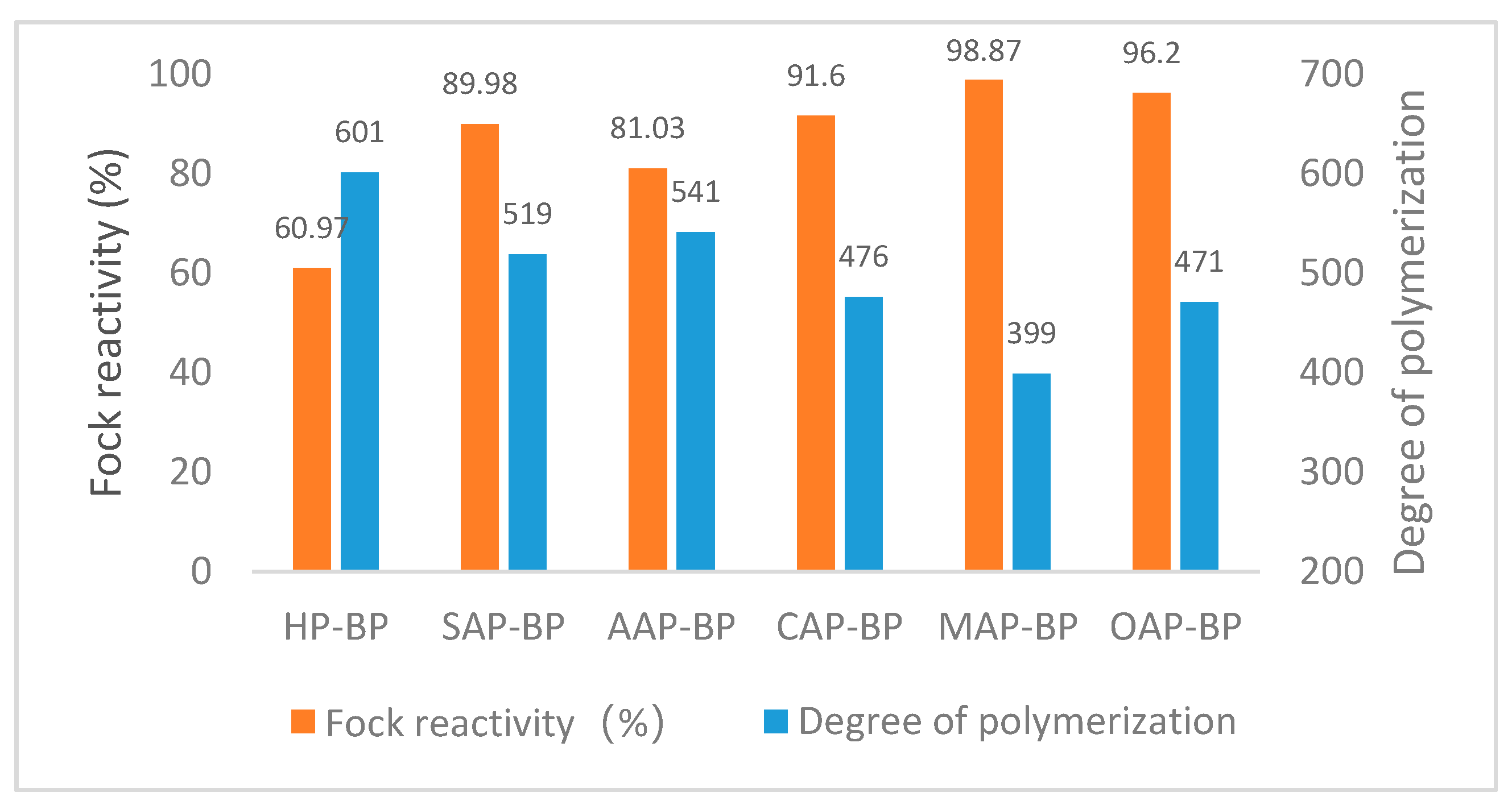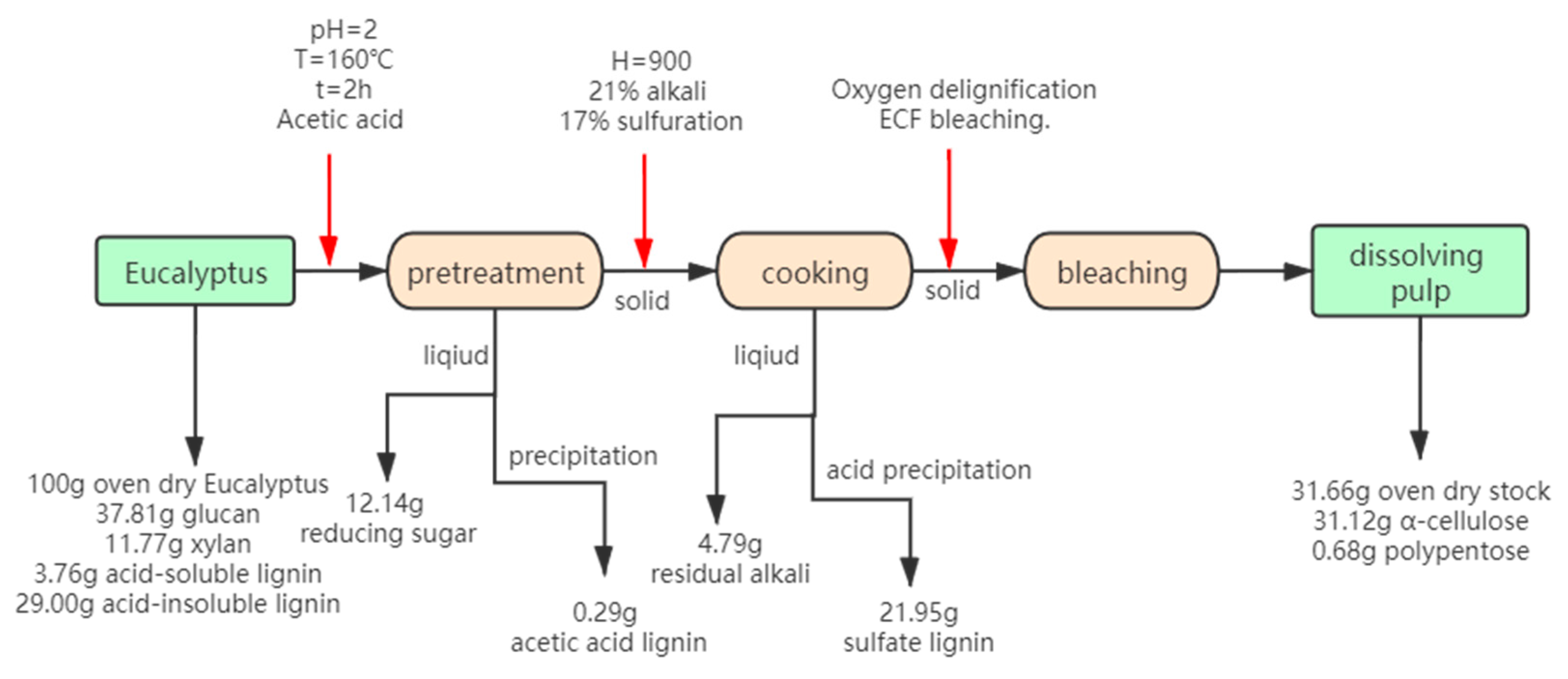1. Introduction
Given the global economic and environmental issues associated with the widespread use of petrochemicals, research on the utilization of biomass is increasing. Lignocellulose materials are the most abundant, renewable, biological resources on the planet, and they are suitable raw materials for sustainable human development [
1,
2,
3]. Biorefineries fulfill the extensive utilization of biomass, and therefore provide additional economic and environmental benefits.
The prehydrolysis kraft process is a well acknowledged process for dissolving pulp production. Pretreatment is an indispensable step for dissolving pulp production. This process can effectively remove hemicellulose and disrupt the structure of the biomass.
Various pretreatment processes were investigated. Generally, they are divided into four categories, including physical, chemical, physicochemical and biological methods [
4]. However, physical pretreatments are not widely used, given the limited effectiveness [
5,
6]. In recent studies, microwave and ultrasound are also used in the pretreatment process. Karunanithy et al. treated switchgrass and big bluestem with extrusion followed by microwave irradiation. Compared to raw materials, it was found that the total sugar recovery was increased by at least 1.14 times through enzymatic hydrolysis, while the extra energy input introduced by microwave irradiation might not be economical [
7]. Physicochemical treatments, such as steam-explosion pretreatment, are carried by high temperature and pressure, and can increase the specific surface area of the fiber. However, safety and cost issues might limit its practical application [
8,
9]. Biological pretreatment is usually carried out under milder conditions, but extended time (from days to weeks) is required to get the desired impact [
10]. Wan et al. reported that Ceriporiopsis subvermispora could remove lignin from hardwood and retain cellulose well, but a long time (18 days) is needed during the pretreatment [
11]. In the pulp production industry, hot water pretreatment and dilute acid pretreatment are the most widely used pretreatment methods. Hot pretreatment is an attractive method for treating lignocellulose biomass because of its environmental friendliness and low operating costs [
12]. However, only a limited amount of hemicellulose can be removed, which is inferior for the hemicellulose utilization, and the cellulose will be seriously degraded with increased pretreatment intensity [
13]. Similarly, dilute sulfuric acid is widely used to pretreat various broad-leaved wood and agricultural waste, because it is effective and economical to remove hemicellulose. However, the significant disadvantages of this method includes the production of inhibitory compounds and the corrosion of the reaction vessel [
14,
15,
16].
Organic acids are increasingly used in biomass pretreatment, because of their efficiency in hydrolyzing lignocellulose biomass with less degradation products and more oligomeric sugars. Lin et al. compared different acid pretreatment methods (with oxalic acid, maleic acid, citric acid and sulfuric acid), and found that organic acid pretreatment makes it easier to recover hemicellulose from the waste liquor of dissolving pulp [
17]. Kwon et al. pretreated the macro-algae Gracilaria verrucosa with citric acid and enzymatically hydrolyzed it to obtain a yield of 57.8% reducing sugar [
18]. Lu et al. analyzed a maleic acid-catalyzed corn stover, and obtained a kinetic model of hemicellulose hydrolysis to obtain a xylose yield of 96% of the theoretical value [
19]. This means that maleic acid is effective at removing xylan, which is necessary to prepare high-quality dissolving pulp, and is also efficient for recovering hemicellulose. It is feasible to produce dissolving pulp from organic acid due to the effective removal of hemicellulose. Through the selective catalysis of oxalic acid, Stein et al. achieved an efficient separation of wood fibers in a two-phase system consisting of water and 2-MTHF [
20]. When Jahan et al. [
21] treated the straw with a mixture of acetic acid/formic acid/water during the biomass refining process, the final cellulose performance reached 93.6% α-cellulose, 5.1% pentosan and 81.8% whiteness. Though there are many studies on the pretreatment of organic acids, a comparative investigation of the effect of organic acid pretreatment for the production of Kraft dissolving pulp is still limited.
In this study, the pretreatment effect of organic acids on wood fibers was compared with conventional hot water pretreatment and sulfuric acids pretreatment. Then, the effects of the pretreatment process were further evaluated by comparing the relative dissolving pulp properties. Finally, the mass balance of the acetic acid pretreatment process was evaluated for the extensive utilization of Eucalyptus in the Kraft dissolving pulp process.
2. Materials and Methods
2.1. Materials
Eucalyptus chips were obtained from the Hunan Province YuNong Paper Co, Ltd. (Luzhou, China), organic acid from the Yonghua fine chemicals Co, Ltd., (Suzhou, China), and all chemicals were of analytical grade.
2.2. Pretreatment Experiments
The wood powder (20–80 mesh) was treated with five different acids (pH = 2 or 3) at different temperatures (150 °C, 160 °C or 170 °C) for 2 h. The solid–liquid ratio was kept at 1:7.
The 2–4 cm eucalyptus chips were sealed to balance moisture before experiment. The deionized water and five different dilute acids were added into the pressure-resistant autoclave containing eucalyptus. The experiments was carried out at the pH value of 2 and at 160 °C for 2 h. The solid–liquid ratio was 1:7.
2.3. Cooking
After the pretreatment, the eucalyptus chips were filled into the reaction kettle for cooking with 21% alkali and 17% sulfidity. The temperature was maintained at 130 °C for 0.5 h, and then heated to 160 °C for 2 h. After the reaction, the pulp was washed to neutral, and then they were sealed and stored in a black plastic bag for testing and bleaching.
2.4. Oxygen Delignification and ECF Bleaching
The original pulps were torn into small pieces to balance moisture. The bleaching process followed a typical ODEP process. The O (oxygen delignification) was carried out in a 500 mL high pressure reaction kettle. After the reactions were completed, the pulps were washed to neutral and squeezed for Elemental-Chlorine-Free bleaching. The section was conducted by DEP three-stage bleaching, in which D was chlorine dioxide treatment, E was an alkaline extraction and P was the hydrogen peroxide bleaching. More specifically, the pulps after oxygen delignification were shredded, then the liquid was fully mixed in the sealed bag, and the pulps were kneaded once every 10–15 min to ensure a uniform reaction. The specific process parameters are shown in
Table 1. Lastly, the pulp was washed thoroughly until it was neutral (pH = 7.0), then we squeezed out the moisture, and put the pulp into a sealed bag to balance the moisture for testing.
2.5. Analysis Method
2.5.1. Analysis of Pretreatment Components
After pretreatment, solids analysis was referenced with NREL [
22]. The wood chips were ground to a size of 20–80 mesh. After being hydrolyzed with 72% sulfuric acid for 1 h, they were diluted to 4% and placed into an autoclave for 1 h at 121 °C. The content of monosaccharides in the liquid was analyzed by high performance liquid chromatography (HPLC).
The ultraviolet–visible (UV-Vis) spectrophotometer was used to determine the acid-soluble lignin content, and the solid residue was acid-insoluble lignin. For HPLC detection, an Aminex HPX87-H column (Bio-Rad, Hercules, CA, USA) was used. The column temperature was 65 °C, the mobile phase was 0.005 mol/L H2SO4, and the flow rate was 0.6 mL/min. A differential refractive index detector was used. A determination of the acid-soluble lignin was carried out using the UV-Vis spectrophotometer (UV-Vis, T6 series, Beijing spectrum analysis General Instrument Co., Ltd., Beijing, China) at 205 nm. Each sample was measured twice and the results are averaged.
Detection of reducing sugar in the pre-hydrolyzed solution [
23]. 3,5-Dinitrosalicylic acid (DNS) was used as a color indicator, and the content was analyzed at 520 nm by the same T6 UV-Vis spectrophotometer.
2.5.2. FTIR Spectroscopy
The samples were freeze-dried and ground into powder. The KBr and samples were mixed and pressed into thin sheets. Finally, the sheets were scanned by Fourier Transform infrared spectroscopy (FTIR, Nicolet iS10, Thermo Fisher Scientific, Waltham, MA, USA) in the frequency range of 4000–400 cm−1 with a resolution of 4 cm−1.
2.5.3. Scanning Electron Microscope (SEM) Analysis
Eucalyptus chips with different pretreatments were dried by liquid nitrogen freeze-drying. After this, they were magnified 2000 times with a Scanning Electron Microscope (SEM) (HITACHI 3400-I, Tokyo, Japan) to observe the surface morphology of the dried wood chips after pretreatments.
2.5.4. X-ray Diffraction Method (XRD)
The dried samples were ground into power. Then the crystallinity of samples was analyzed by X-ray diffractometer (XRD) (D8-FOUS, Bruker, Kalsruhe, Germany). The scattering angle (2θ) ranged from 10° to 50° with 0.02 increments. The crystallinity index (CrI) was calculated as the following Equation (1) [
24]:
where I
002 is the intensity of the crystalline peak at about 2θ = 22°–23°, attributed to crystalline regions and I
am is the intensity at about 2θ = 18°–19°, attributed to amorphous regions.
2.5.5. Fiber Quality Analysis
A small number of samples were mixed with 20 mL of deionized water, and then the mixture was shaken in the test tube vigorously until there are no bundled fibers. Lastly, the fine fiber content, fiber length and fiber width of the sample was analyzed with a fiber quality analyzer (OpTest Equipment Inc., Hawkesbury, ON, Canada).
2.5.6. Fock Reactivity and Degree of Polymerization
Fock reactivity was determined similarly with a previous report [
25]. Simply speaking, 0.500 (± 0.004) g of the dried pulp sample was dispersed in 50 mL of 9% NaOH and 1.3 mL of CS
2. The mixture was shaken at 19 °C under 250 rpm for 3 h. Then, deionized water was added to make the solution a total weight of 100 g. After centrifugation at 5000 rpm for 15 min, 10 mL of supernatant was added into 3 mL of 20% sulfuric acid to neutral. The regenerated cellulose was obtained after 20 h. Then, 20 mL 68% sulfuric acid was added to the solution with stirring for 1 h to acidify the cellulose. Then, 10 mL K
2Cr
2O
7 (1/6 mol/L) was added into the solution, and refluxed for 1 h to oxidize the cellulose. Finally, excess KI solution was added. The final solution was titrated with sodium thiosulfate with starch as an indicator. The calculation method is as Equation (2):
The polymerization degree of the dissolving pulps were calculated from the viscosity, PD0.905 = 0.75 [η]. Each sample was conducted twice.
2.5.7. Other Test Analysis
All other analyses were based on the Chinese national standards. Pentosan measurement was based upon GB/T 745-2003. Specifically, a 1 g sample was azeotroped with a certain amount of 12% hydrochloric acid (distillated 30 mL every 10 min, 300 mL in total), to convert pentosan to furfural. Then the furfural was interacted with Br
2, and the excess Br
2 was reduced with KI. Lastly, the reduced I
2 was titrated with Na
2S
2O
3 (0.1 mol/L). The conversion of furfural to pentosan was multiplied by a factor of 1.88. One molecule of furfural consumed 4.05 molecules of Br
2. As Equation (3):
The Kappa number was determined by the method in Appendix A of the GB/T 1546-2004 [
3]. Specifically, the sample of pulp was oxidized with 0.02 mol/L acid potassium permanganate standard solution for 5 min at 25 °C, and excess KMNO
4 was reduced with KI. Lastly, the reduced I
2 was titrated with Na
2S
2O
3 (0.1 mol/L). As Equations (4) and (5):
The viscosity of the samples were measured using cupriethylenediamine (CED) solution as the solvent [
26]. Specifically, 0.5 mg of pulp was dissolved in 25 mL of CED and 25 mL of water. After this, the time that the solution flowed out of the capillary viscometer was recorded with a stopwatch. As Equations (6) and (7):
The relationship of [η] × ρ and relative viscosity was referred for the table A [
26].
The α-cellulose measured was based on GB/T 744-1989 [
27]. Specifically, the mercerization treatment of the 2 g sample of pulp was conducted by 17.5% NaOH (
w/
w) and dissolved by 9.5% NaOH (
w/
w), and the residue was α-cellulose.
Whiteness was tested according to GB/T 8940.2-1988 [
28], and two handsheets were prepared for whiteness testing, and the whiteness test was conducted with a whiteness meter (WS-SD, WENZHOU INSTRUMENTS & METERS CO., LTD, Wenzhou, China). Each sample was conducted twice.
Each test was conducted twice and the final results were taken by the average of the measurements.
2.6. Evaluated Treatments of Dissolving Pulp Production of Acetic Acid Pretreatment
The recovery rate of reducing sugar was calculated with reducing sugar concentration multiplying by the volume of recovered liquid. The recovery method of acetic acid lignin were by adding deionized water (5:1) [
29]. The lignin sulfate was obtained by adjusting the pH of the waste liquid to 2, followed by washing and centrifugation [
30].
4. Conclusions
In this paper, the effect of various organic acid pretreatment for Kraft dissolving pulp production was comparatively investigated. The pretreatment condition for organic acid pretreatment was optimized (160 °C, 2 h, pH = 2). Compared with other organic acids (citrate acid, maleic acid and oxalic acid), acetic acid alleviates cellulose degradation due to the solvent effect. Besides, acetic acid exhibited better hemicellulose removal over autohydrolysis pretreatment. For the Kraft dissolving pulp properties, acetic acid pretreatment demonstrated higher yield (31.66%) and higher α-cellulose (98.28%) over other organic acid pretreatment, and lower hemicellulose content (2.14%) compared with autohydrolysis pretreatment. Also, the Fock reactivity attained 81.03%. Acetic acid pretreatment-derived dissolving pulp can meet the commercial index of dissolving pulp. The dissolving pulp obtained by other organic acid pretreatment had more fine fiber content due to the excessive acid hydrolysis of cellulose. Moreover, the extensive utilization of biomass was evaluated. 43.8% polysaccharide (12.14% reducing sugar and 31.66% dissolving pulp) and 22.24% lignin (0.29% acetic acid lignin and 21.95% sulfate lignin) were recovered. Biomass utilization could reach 66.04%. Acetic acid pretreatment process fulfilled the biorefinery concept and showed the potential application for the Kraft dissolving pulp. Overall, the acetic acid process is a promising pretreatment method for extensive biomass utilization.









